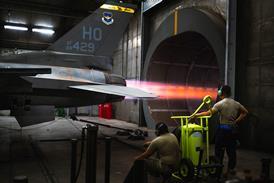Peter La Franchi/MELBOURNE
The Australian Department of Defence is to fund a series of risk mitigation and technology requirements studies to boost local industry support arrangements for its Project Air 6000 future fighter programme.
Studies will include mapping Australian aerospace capabilities and deficiencies against technologies now being applied to the world's premier combat aircraft.
According to AVM Norm Gray, former head of aerospace development in the Australian defence headquarters and now the head of RAAF's airborne early warning and control programme, the studies will "look at specific areas of technology where it is beneficial for Australia to be able to have the knowledge of that technology for the through-life support of whatever it is that we buy".
Speaking at a RAAF/Association of Australian Aerospace Industries conference earlier this month, Gray said the studies would compare "levels of technology we currently have in the country against the sort of technologies that are likely to come in the Air 6000 solution". The results would be used to "identify where the high pay-off areas are to get involved in".
Gray says the studies have a close parallel to similar industry capability studies being carried out by the UK as part of its Future Offensive Air System programme.
The studies, he says, would be structured around a nucleus comprising the Australian Defence Science and Technology Organisation and local industry, "but linked internationally wherever possible".
Meanwhile, BAE Systems Australia is urging the Australian Department of Defence not to stretch out its assessment of Air 6000 candidates to ensure bidders' costs remain acceptable.
The company is calling for a nominal shortlist of preferred aircraft to be finalised before 2004, at least two years ahead of Australian plans for the launch of the first tranche of a proposed three-phase purchase.
BAE has been actively pursuing the requirement with the Eurofighter Typhoon, but has recently been asked by the Air 6000 project office to also provide data on the Saab/BAE Gripen.
"What we are going to be asking the project office is to, as quickly as possible, make it clear exactly what the likely shortlist is going to be." says chief executive of BAE Australia Peter Anstiss
BAE does not wish to "waste money, time and effort in promoting an aircraft, conducting flight trials, and at worst case, bringing production aircraft around the world to demonstrate if ultimately the specification involves something that would eliminate the Gripen."
Source: Flight International























